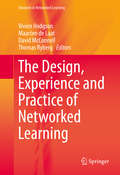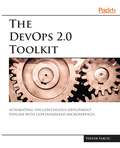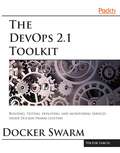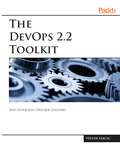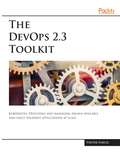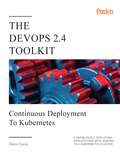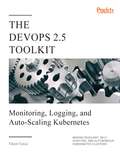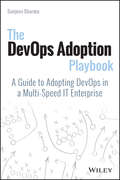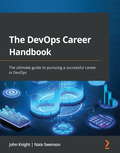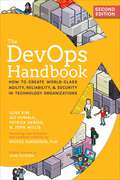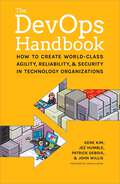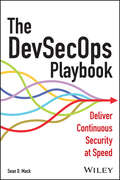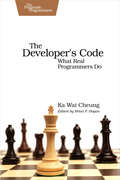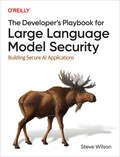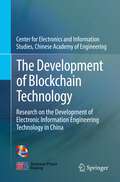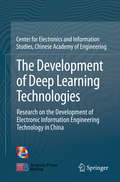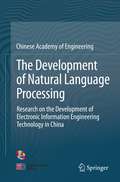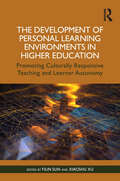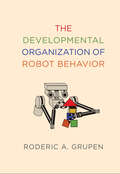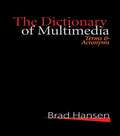- Table View
- List View
The Design, Experience and Practice of Networked Learning
by David Mcconnell Vivien Hodgson Thomas Ryberg Maarten De LaatThe Design, Experience and Practice of Networked Learning Edited by: Vivien Hodgson, Maarten de Laat, David McConnell and Thomas Ryberg This book brings together a wealth of new research that opens up the meaning of connectivity as embodied and promised in the term ''networked learning''. Chapters explore how contexts, groups and environments can be connected rather than just learners; how messy, unexpected and emergent connections can be made rather than structured and predefined ones; and how technology connects us to learning and each other, but also shapes our identity. These exciting new perspectives ask us to look again at what we are connecting and to revel in new and emergent possibilities arising from the interplay of social actors, contexts, technologies, and learning. Caroline Haythornthwaite, University of British Columbia Despite creating fundamentally new educational economics and greatly increasing access - teaching and learning in networks is a tricky business. These chapters illuminate the complex interactions amongst tools, pedagogy, educational institutions and personal net presences - helping us design and redesign our own networks. In the process, they take (or extract) network theory from the practice of real teaching and learning contexts, making this collection an important contribution to Networked Learning. Terry Anderson, Athabasca University What kinds of learning can social networking platforms really enable? Digging well beneath the hype, this book provides a timely, incisive analysis of why and how learning emerges (or fails to) in networked spaces. The editors do a fine job in guiding the reader through the rich array of theories and methods for tackling this question, and the diverse contexts in which networked learning is now being studied. This is a book for reflective practitioners as well as academics: the book''s close attention to the political, pedagogical and organisational complexity of effective practice, and the lived experience of educators and learners, helps explain why networked learning has such disruptive potential -- but equally, why it draws resistance from the establishment. Simon Buckingham Shum, The Open University The networked learning conference, a biannual institution since 1998, celebrates its 14th year in this volume. Here a range of studies, reflecting networked learning experiments across Europe and other global contexts , show important shifts away from a conservative tradition of OEe-learning¹ research and unpeel dilemmas of promoting learning as an elusive practice in virtual environments. The authors point towards important futures in online learning research, where notions of knowledge, connectivity and OEcommunity¹ become increasingly elastic, and engagements slide across material and virtual domains in new practices whose emergence is increasingly difficult to apprehend. Tara Fenwick - University of Stirling. The chapters in this volume explore new and innovative ways of thinking about the nature of networked learning and its pedagogical values and beliefs. They pose a challenge to us to reflect on what we thought networked learning was 15 year ago, where it is today and where it is likely to be headed. Each chapter brings a particular perspective to the themes of design, experience and practice of networked learning, the chosen focus of the book. The chapters in the book embrace a wide field of educational areas including those of higher education, informal learning, work-based learning, continuing professional development, academic staff development, and management learning. The Design, Experience and Practice of Networked Learning will prove indispensable reading for researchers, teachers, consultants, and instructional designers in higher and continuing education; for those involved in staff and educational development, and for those studying post graduate qualifications in learning and teaching. This, the second volume in the Springer Book Series on Researching Networked Learning, is based on a selection of papers presented a...
The Designer's Web Handbook
by Patrick McneilMake the Web Work for You You know how to design. But you can increase your value as a designer in the marketplace by learning how to make that design function on the web. From informational sites to e-commerce portals to blogs to mobile apps, The Designer's Web Handbook helps any designer understand the full life cycle of a digital product: idea, design, production and maintenance. The best web designers create not only beautiful sites but also sites that function well--for both client and end user. Patrick McNeil, creator of the popular web design blog designmeltdown.com and author of the bestselling Web Designer's Idea Book, volumes 1 and 2, teaches you how to work with developers to build sites that balance aesthetics and usability, and to do it on time and on budget.
The Designer's Web Handbook: What You Need to Know to Create for the Web
by Patrick McneilMake the Web Work for YouYou know how to design. But you can increase your value as a designer in the marketplace by learning how to make that design function on the web. From informational sites to e-commerce portals to blogs to mobile apps, The Designer's Web Handbook helps any designer understand the full life cycle of a digital product: idea, design, production and maintenance.The best web designers create not only beautiful sites but also sites that function well--for both client and end user. Patrick McNeil, creator of the popular web design blog designmeltdown.com and author of the bestselling Web Designer's Idea Book, volumes 1 and 2, teaches you how to work with developers to build sites that balance aesthetics and usability, and to do it on time and on budget.
The Designer's Web Handbook: What You Need to Know to Create for the Web
by Patrick McneilMake the Web Work for YouYou know how to design. But you can increase your value as a designer in the marketplace by learning how to make that design function on the web. From informational sites to e-commerce portals to blogs to mobile apps, The Designer's Web Handbook helps any designer understand the full life cycle of a digital product: idea, design, production and maintenance.The best web designers create not only beautiful sites but also sites that function well--for both client and end user. Patrick McNeil, creator of the popular web design blog designmeltdown.com and author of the bestselling Web Designer's Idea Book, volumes 1 and 2, teaches you how to work with developers to build sites that balance aesthetics and usability, and to do it on time and on budget.
The Designers WEB Handbook
by Patrick McneilDesigners don't have to know how to code to design for the Web, but they must understand the constraints of the medium and how it really works. This book helps designers understand the mechanics of the Web, which, in turn, increase their value as a designer.
The DevOps 2.0 Toolkit
by Viktor FarcicAutomating the Continuous Deployment Pipeline with Containerized Microservices About This Book * First principles of devops, Ansible, Docker, Kubernetes, microservices * Architect your software in a better and more efficient way with microservices packed as immutable containers * Practical guide describing an extremely modern and advanced devops toolchain that can be improved continuously Who This Book Is For If you are an intermediate-level developer who wants to master the whole microservices development and deployment lifecycle using some of the latest and greatest practices and tools, this is the book for you. Familiarity with the basics of Devops and Continuous Deployment will be useful. What You Will Learn * Get to grips with the fundamentals of Devops * Architect efficient software in a better and more efficient way with the help of microservices * Use Docker, Kubernetes, Ansible, Ubuntu, Docker Swarm and more * Implement fast, reliable and continuous deployments with zero-downtime and ability to roll-back * Learn about centralized logging and monitoring of your cluster * Design self-healing systems capable of recovery from both hardware and software failures In Detail Building a complete modern devops toolchain requires not only the whole microservices development and a complete deployment lifecycle, but also the latest and greatest practices and tools. Victor Farcic argues from first principles how to build a devops toolchain. This book shows you how to chain together Docker, Kubernetes, Ansible, Ubuntu, and other tools to build the complete devops toolkit. Style and approach This book follows a unique, hands-on approach familiarizing you to the Devops 2.0 toolkit in a very practical manner. Although there will be a lot of theory, you won't be able to complete this book by reading it in a metro on a way to work. You'll need to be in front of your computer and get your hands dirty.
The DevOps 2.1 Toolkit: Docker Swarm
by Viktor FarcicViktor Farcic's latest book, The DevOps 2.1 Toolkit: Docker Swarm, shows you how to successfully integrate Docker Swarm into your DevOps toolset. About This Book • Expand your DevOps Toolkit with the DevOps thought leader, Viktor Farcic • Build, test, deploy, and monitor services inside Docker Swarm clusters • Translate your understanding to different hosting providers like AWS, Azure, and DigitalOcean • Go beyond simple deployment to explore how to create a continuous deployment process • Extend the deep understanding you gained from Viktor's DevOps 2.0 Toolkit book Who This Book Is For This book is for professionals interested in the full microservices life cycle combined with continuous deployment and containers. Target audience could be architects who want to know how to design their systems around microservices. It could be DevOps wanting to know how to apply modern configuration management practices and continuously deploy applications packed in containers. It is for developers who would like to take the process back into their hands as well as for managers who would like to gain a better understanding of the process used to deliver software from the beginning to the end. This book is for everyone wanting to know more about the software development life cycle starting from requirements and design, through the development and testing all the way until deployment and post-deployment phases. We'll create the processes taking into account the best practices developed by and for some of the biggest companies. What You Will Learn • Learn all aspects of Docker Swarm from building, testing, deploying, and monitoring services inside Docker Swarm clusters, available since Docker 1.12. • Master the deeper logic of DevOps with Viktor, so that you can successfully apply that logic across any specific set of tools you're working with. • Translate a deep understanding to different hosting providers like AWS, Azure, DigitalOcean, among others. • You'll go beyond simple deployment: you will explore with Viktor how to create a continuous deployment process. Accomplish zero-downtime deployments, and what to do in case of a failover. • Know how to run services at scale, how to monitor the systems, and how to make it heal itself. In Detail Viktor Farcic's latest book, The DevOps 2.1 Toolkit: Docker Swarm, takes you deeper into one of the major subjects of his international best seller, The DevOps 2.0 Toolkit, and shows you how to successfully integrate Docker Swarm into your DevOps toolset. Viktor shares with you his expert knowledge in all aspects of building, testing, deploying, and monitoring services inside Docker Swarm clusters. You'll go through all the tools required for running a cluster. You'll travel through the whole process with clusters running locally on a laptop. Once you're confident with that outcome, Viktor shows you how to translate your experience to different hosting providers like AWS, Azure, and DigitalOcean. Viktor has updated his DevOps 2.0 framework in this book to use the latest and greatest features and techniques introduced in Docker. We'll go through many practices and even more tools. While there will be a lot of theory, this is a hands-on book. You won't be able to complete it by reading it on the metro on your way to work. You'll have to read this book while in front of the computer and get your hands dirty. Style and approach We'll go through many practices and even more tools. While there will be a lot of theory, this is a hands-on book. You'll have to read this book while in front of the computer and get your hands dirty. The goal is not to master one particular set of tools, but to learn the logic behind them so that you can apply it to your job in various contexts.
The DevOps 2.2 Toolkit: Self-Sufficient Docker Clusters
by Viktor FarcicLearn from an expert on how use self-adapting and self-healing systems within Docker.Key Features Viktor Farcic shows you all aspects in the creation of self-adapting and self-healing systems in both a practical and hands-on approach. Learn how to choose a successful solution for metrics storage and query, including InfluxDB, Nagios and Sensu, Prometheus and Graphite. Discover how to integrate Docker Flow Monitor with Docker Flow Proxy. How to apply Docker self-healing and self-adaptive to both services and infrastructure.Book DescriptionBuilding on The DevOps 2.0 Toolkit and The DevOps 2.1 Toolkit: Docker Swarm, Viktor Farcic brings his latest exploration of the Docker technology as he records his journey to explore two new programs, self-adaptive and self-healing systems within Docker. The DevOps 2.2 Toolkit: Self-Sufficient Docker Clusters is the latest book in Viktor Farcic’s series that helps you build a full DevOps Toolkit. This book in the series looks at Docker, the tool designed to make it easier in the creation and running of applications using containers. In this latest entry, Viktor combines theory with a hands-on approach to guide you through the process of creating self-adaptive and self-healing systems. Within this book, Viktor will cover a wide-range of emerging topics, including what exactly self-adaptive and self-healing systems are, how to choose a solution for metrics storage and query, the creation of cluster-wide alerts and what a successful self-sufficient system blueprint looks like. Work with Viktor and dive into the creation of self-adaptive and self-healing systems within Docker.What you will learn Let Viktor Farcic show you all aspects in the creation of self-adapting and self-healing systems in both a practical and hands-on approach. Learn how to choose a successful solution for metrics storage and query, including InfluxDB, Nagios and Sensu, Prometheus and Graphite. Understand how to integrate Docker Flow Monitor with Docker Flow Proxy. The creation of cluster-wide alerts by creating alerts based on metrics. How to apply self-healing and self-adaptive to both services and infrastructure.Who this book is forThis book is for professionals experienced with Docker looking to create both self-adapting and self-healing systems using the software.
The DevOps 2.3 Toolkit: Kubernetes: Deploying and managing highly-available and fault-tolerant applications at scale
by Viktor FarcicLearn from an expert on how to use Kubernetes, the most adopted container orchestration platform. About This Book • Get a detailed, hands-on exploration of everything from the basic to the most advanced aspects of Kubernetes • Explore the tools behind not only the official project but also the third-party add-ons • Learn how to create a wide range of tools, including clusters, Role Bindings, and Ingress Resources with default backends, among many applicable, real-word creations • Discover how to deploy and manage highly available and fault-tolerant applications at scale with zero downtime Who This Book Is For This book is for professionals experienced with Docker, looking to get a detailed overview from the basics to the advanced features of Kubernetes. What You Will Learn • Let Viktor show you the wide range of features available in Kubernetes—from the basic to the most advanced features • Learn how to use the tools not only from the official project but also from the wide range of third-party add-ons • Understand how to create a pod, how to Scale Bids with Replica Sets, and how to install both Kubectl and Minikube • Explore the meaning of terms such as container scheduler and Kubernetes • Discover how to create a local Kubernetes cluster and what to do with it In Detail Building on The DevOps 2.0 Toolkit, The DevOps 2.1 Toolkit: Docker Swarm, and The DevOps 2.2 Toolkit: Self-Sufficient Docker Clusters, Viktor Farcic brings his latest exploration of the DevOps Toolkit as he takes you on a journey to explore the features of Kubernetes. The DevOps 2.3 Toolkit: Kubernetes is a book in the series that helps you build a full DevOps Toolkit. This book in the series looks at Kubernetes, the tool designed to, among other roles, make it easier in the creation and deployment of highly available and fault-tolerant applications at scale, with zero downtime. Within this book, Viktor will cover a wide range of emerging topics, including what exactly Kubernetes is, how to use both first and third-party add-ons for projects, and how to get the skills to be able to call yourself a “Kubernetes ninja.” Work with Viktor and dive into the creation and exploration of Kubernetes with a series of hands-on guides. Style and approach Readers join Viktor Farcic as he continues his exploration of DevOps and begins to explore the opportunities presented by Kubernetes.
The DevOps 2.4 Toolkit: Continuous Deployment to Kubernetes: Continuously deploying applications with Jenkins to a Kubernetes cluster (The\devops Toolkit Ser.)
by Viktor FarcicAn exploration of continuous deployment to a Kubernetes cluster, using a wide range of Kubernetes platforms with instructions on how to develop a pipeline on a few of the most commonly used CI/CD platforms. Key Features The fifth book of DevOps expert Viktor Farcic's bestselling DevOps Toolkit series, with a discussion of the difference between continuous delivery vs. continuous deployment, and which is best for the user Guides readers through the continuous deployment process using Jenkins in a Kubernetes cluster Provides an overview of the best practices for building, testing, and deploying applications through fully automated pipelines. Book Description Building on The DevOps 2.3 Toolkit: Kubernetes, Viktor Farcic brings his latest exploration of the Docker technology as he records his journey to continuously deploying applications with Jenkins into a Kubernetes cluster. The DevOps 2.4 Toolkit: Continuously Deploying Applications with Jenkins to a Kubernetes Cluster is the latest book in Viktor Farcic's series that helps you build a full DevOps Toolkit. This book guides readers through the process of building, testing, and deploying applications through fully automated pipelines. Within this book, Viktor will cover a wide-range of emerging topics, including an exploration of continuous delivery and deployment in Kubernetes using Jenkins. It also shows readers how to perform continuous integration inside these clusters, and discusses the distribution of Kubernetes applications, as well as installing and setting up Jenkins. Work with Viktor and dive into the creation of self-adaptive and self-healing systems within Docker. What you will learn Gain an understanding of continuous deployment Learn how to build, test, and deploy applications into Kubernetes Execute continuous integration inside containers Who this book is for Readers with an intermediate level understanding of Kubernetes and hands-on experience.
The DevOps 2.5 Toolkit: Monitoring, Logging, and Auto-Scaling Kubernetes: Making Resilient, Self-Adaptive, And Autonomous Kubernetes Clusters (The\devops Toolkit Ser.)
by Viktor FarcicAn advanced exploration of the skills and knowledge required for operating Kubernetes clusters, with a focus on metrics gathering and alerting, with the goal of making clusters and applications inside them autonomous through self-healing and self-adaptation. Key Features The sixth book of DevOps expert Viktor Farcic's bestselling DevOps Toolkit series, with an overview of advanced core Kubernetes techniques,-oriented towards monitoring and alerting. Takes a deep dive into monitoring, alerting, logging, auto-scaling, and other subjects aimed at making clusters resilient, self-sufficient, and self-adaptive Discusses how to customise and create dashboards and alerts Book Description Building on The DevOps 2.3 Toolkit: Kubernetes, and The DevOps 2.4 Toolkit: Continuous Deployment to Kubernetes, Viktor Farcic brings his latest exploration of the Docker technology as he records his journey to monitoring, logging, and autoscaling Kubernetes. The DevOps 2.5 Toolkit: Monitoring, Logging, and Auto-Scaling Kubernetes: Making Resilient, Self-Adaptive, And Autonomous Kubernetes Clusters is the latest book in Viktor Farcic's series that helps you build a full DevOps Toolkit. This book helps readers develop the necessary skillsets needed to be able to operate Kubernetes clusters, with a focus on metrics gathering and alerting with the goal of making clusters and applications inside them autonomous through self-healing and self-adaptation. Work with Viktor and dive into the creation of self-adaptive and self-healing systems within Kubernetes. What you will learn Autoscaling Deployments and Statefulsets based on resource usage Autoscaling nodes of a Kubernetes cluster Debugging issues discovered through metrics and alerts Extending HorizontalPodAutoscaler with custom metrics Visualizing metrics and alerts Collecting and querying logs Who this book is for Readers with an advanced-level understanding of Kubernetes and hands-on experience.
The DevOps Adoption Playbook: A Guide to Adopting DevOps in a Multi-Speed IT Enterprise
by Sanjeev SharmaAchieve streamlined, rapid production with enterprise-level DevOps Awarded DevOps 2017 Book of the Year, The DevOps Adoption Playbook provides practical, actionable, real-world guidance on implementing DevOps at enterprise scale. Author Sanjeev Sharma heads the DevOps practice for IBM; in this book, he provides unique guidance and insight on implementing DevOps at large organizations. Most DevOps literature is aimed at startups, but enterprises have unique needs, capabilities, limitations, and challenges; "DevOps for startups" doesn't work at this scale, but the DevOps paradigm can revolutionize enterprise IT. Deliver high-value applications and systems with velocity and agility by adopting the necessary practices, automation tools, and organizational and cultural changes that lead to innovation through rapid experimentation. Speed is an advantage in the face of competition, but it must never come at the expense of quality; DevOps allows your organization to keep both by intersecting development, quality assurance, and operations. Enterprise-level DevOps comes with its own set of challenges, but this book shows you just how easily they are overcome. With a slight shift in perspective, your organization can stay ahead of the competition while keeping costs, risks, and quality under control. Grasp the full extent of the DevOps impact on IT organizations Achieve high-value innovation and optimization with low cost and risk Exceed traditional business goals with higher product release efficiency Implement DevOps in large-scale enterprise IT environments DevOps has been one of IT's hottest trends for the past decade, and plenty of success stories testify to its effectiveness in organizations of any size, industry, or level of IT maturity, all around the world. The DevOps Adoption Playbook shows you how to get your organization on board so you can slip production into the fast lane and innovate your way to the top.
The DevOps Career Handbook: The ultimate guide to pursuing a successful career in DevOps
by John Knight Nate SwensonExplore the diverse DevOps career paths and prepare for each stage of the interview process with collective wisdom from DevOps experts and interviews with DevOps Practitioners Key FeaturesNavigate the many career opportunities in the field of DevOpsDiscover proven tips and tricks from industry experts for every step of the DevOps interviewSave both time and money by avoiding common mistakes in your interviewsBook DescriptionDevOps is a set of practices that make up a culture, and practicing DevOps methods can make developers more productive and easier to work with. The DevOps Career Handbook is filled with hundreds of tips and tricks from experts regarding every step of the interview process, helping you save time and money by steering clear of avoidable mistakes.You'll learn about the various career paths available in the field of DevOps, before acquiring the essential skills needed to begin working as a DevOps professional. If you are already a DevOps engineer, this book will help you to gain advanced skills to become a DevOps specialist. After getting to grips with the basics, you'll discover tips and tricks for preparing your resume and online profiles and find out how to build long-lasting relationships with the recruiters. Finally, you'll read through interviews which will give you an insight into a career in DevOps from the viewpoint of individuals at different career levels.By the end of this DevOps book, you'll gain a solid understanding of what DevOps is, the various DevOps career paths, and how to prepare for your interview.What you will learnUnderstand various roles and career paths for DevOps practitionersDiscover proven techniques to stand out in the application processPrepare for the many stages of your interview, from the phone screen to taking the technical challenge and then the onsite interviewNetwork effectively to help your career move in the right directionTailor your resume to specific DevOps rolesDiscover how to negotiate after you've been extended an offerWho this book is forThis book is for DevOps professionals looking to take the next step in their career, engineers looking to make a career switch, technology managers who want to understand the complete picture of the DevOps landscape, and anyone interested in incorporating DevOps into their tech journey.
The DevOps Handbook: How to Create World-Class Agility, Reliability, & Security in Technology Organizations
by Jez Humble John Willis Gene Kim Patrick Debois Nicole ForsgrenThis award-winning and bestselling business handbook for digital transformation is now fully updated and expanded with the latest research and new case studies!&“[The DevOps Handbook] remains a must-read for any organization seeking to scale up its IT capability and expand DevOps practices across multiple departments or lines of business.&” —Mike Perrow, TechBeaconFor years, The DevOps Handbook has been the definitive guide for taking the successes laid out in the bestselling The Phoenix Project and applying them in any organization. Now, with this fully updated and expanded edition, it's time to take DevOps out of the IT department and apply it across the full business.Technology is now at the core of every company, no matter the business model or product. The theories and practices laid out in The DevOps Handbook are tools to be used by anyone from across the organization to create joy and succeed in the marketplace. The second edition features 15 new case studies, including stories from Adidas, American Airlines, Fannie Mae, Target, and the US Air Force. In addition, renowned researcher and coauthor of Accelerate, Dr. Nicole Forsgren, provides her insights through new and updated material and research. With over 100 pages of new content throughout the book, this expanded edition is a must read for anyone who works with technology.&“[The DevOps Handbook is] a practical roadmap to improving IT in any organization. It's also the most valuable book on software development I've read in the past 10 years.&” —Adam Hawkins, software developer and host of the podcast SmallBatches
The DevOps Handbook: How to Create World-Class Agility, Reliability, and Security in Technology Organizations
by Jez Humble John Willis Gene Kim Patrick DeboisIncrease profitability, elevate work culture, and exceed productivity goals through DevOps practices.More than ever, the effective management of technology is critical for business competitiveness. For decades, technology leaders have struggled to balance agility, reliability, and security. The consequences of failure have never been greater—whether it's the healthcare.gov debacle, cardholder data breaches, or missing the boat with Big Data in the cloud.And yet, high performers using DevOps principles, such as Google, Amazon, Facebook, Etsy, and Netflix, are routinely and reliably deploying code into production hundreds, or even thousands, of times per day.Following in the footsteps of The Phoenix Project, The DevOps Handbook shows leaders how to replicate these incredible outcomes, by showing how to integrate Product Management, Development, QA, IT Operations, and Information Security to elevate your company and win in the marketplace.
The DevSecOps Playbook: Deliver Continuous Security at Speed
by Sean D. MackThe DevSecOps Playbook An essential and up-to-date guide to DevSecOps In The DevSecOps Playbook: Deliver Continuous Security at Speed, the Chief Information and Information Security Officer at Wiley, Sean D. Mack, delivers an insightful and practical discussion of how to keep your business secure. You’ll learn how to leverage the classic triad of people, process, and technology to build strong cybersecurity infrastructure and practices. You’ll also discover the shared responsibility model at the core of DevSecOps as you explore the principles and best practices that make up contemporary frameworks. The book explains why it’s important to shift security considerations to the front-end of the development cycle and how to do that, as well as describing the evolution of the standard security model over the last few years and how that has impacted modern cybersecurity. A must-read roadmap to DevSecOps for practicing security engineers, security leaders, and privacy practitioners, The DevSecOps Playbook will also benefit students of information technology and business, as well as governance, risk, and compliance specialists who want to improve their understanding of cybersecurity’s impact on their organizations.
The Developer's Code: What Real Programmers Do (Oreilly And Associate Ser.)
by Ka Wai CheungYou're already a great coder, but awesome coding chops aren't always enough to get you through your toughest projects. You need these 50+ nuggets of wisdom. Veteran programmers: reinvigorate your passion for developing web applications. New programmers: here's the guidance you need to get started. With this book, you'll think about your job in new and enlightened ways.The Developer's Code isn't about the code you write, it's about the code you live by.There are no trite superlatives here. Packed with lessons learned from more than a decade of software development experience, author Ka Wai Cheung takes you through the programming profession from nearly every angle to uncover ways of sustaining a healthy connection with your work.You'll see how to stay productive even on the longest projects. You'll create a workflow that works with you, not against you. And you'll learn how to deal with clients whose goals don't align with your own. If you don't handle them just right, issues such as these can crush even the most seasoned, motivated developer. But with the right approach, you can transcend these common problems and become the professional developer you want to be.In more than 50 nuggets of wisdom, you'll learn:Why many traditional approaches to process and development roles in this industry are wrong - and how to sniff them out.Why you must always say "no" to the software pet project and open-ended timelines.How to incorporate code generation into your development process, and why its benefits go far beyond just faster code output.What to do when your client or end user disagrees with an approach you believe in.How to pay your knowledge forward to future generations of programmers through teaching and evangelism.If you're in this industry for the long run, you'll be coming back to this book again and again.
The Developer's Playbook for Large Language Model Security: Building Secure AI Applications
by Steve WilsonLarge language models (LLMs) are not just shaping the trajectory of AI, they're also unveiling a new era of security challenges. This practical book takes you straight to the heart of these threats. Author Steve Wilson, chief product officer at Exabeam, focuses exclusively on LLMs, eschewing generalized AI security to delve into the unique characteristics and vulnerabilities inherent in these models.Complete with collective wisdom gained from the creation of the OWASP Top 10 for LLMs list—a feat accomplished by more than 400 industry experts—this guide delivers real-world guidance and practical strategies to help developers and security teams grapple with the realities of LLM applications. Whether you're architecting a new application or adding AI features to an existing one, this book is your go-to resource for mastering the security landscape of the next frontier in AI.You'll learn:Why LLMs present unique security challengesHow to navigate the many risk conditions associated with using LLM technologyThe threat landscape pertaining to LLMs and the critical trust boundaries that must be maintainedHow to identify the top risks and vulnerabilities associated with LLMsMethods for deploying defenses to protect against attacks on top vulnerabilitiesWays to actively manage critical trust boundaries on your systems to ensure secure execution and risk minimization
The Development of Blockchain Technology: Research on the Development of Electronic Information Engineering Technology in China
by Center for Electronics and Information Studies, Chinese Academy of EngineeringThis book is a part of the Blue Book series “Research on the Development of Electronic Information Engineering Technology in China”, which explores the cutting edge of blockchain technology studies.The research objects of blockchain are the concept, development process, core value of blockchain, and focuses on the core technology and classification of blockchain technology. And summarizes the development situation of the global and Chinese blockchain industry, including the status quo of policy measures, standard construction, and application development. Finally, summarize the main innovation points of blockchain technology, including its development in China, and prospects the future development of blockchain technology. This book is intended for researchers and industrial staffs who have been following the current situation and future trends of the blockchain. Meanwhile, it also bears high value of reference for experts, scholars, and technical and engineering managers of different levels and different fields.
The Development of Deep Learning Technologies: Research on the Development of Electronic Information Engineering Technology in China
by Chinese Academy of EngineeringThis book is a part of the Blue Book series “Research on the Development of Electronic Information Engineering Technology in China,” which explores the cutting edge of deep learning studies. A subfield of machine learning, deep learning differs from conventional machine learning methods in its ability to learn multiple levels of representation and abstraction by using several layers of nonlinear modules for feature extraction and transformation. The extensive use and huge success of deep learning in speech, CV, and NLP have led to significant advances toward the full materialization of AI. Focusing on the development of deep learning technologies, this book also discusses global trends, the status of deep learning development in China and the future of deep learning.
The Development of Natural Language Processing: Research on the Development of Electronic Information Engineering Technology in China
by China Info & Comm Tech Grp CorpThis book is a part of the Blue Book series “Research on the Development of Electronic Information Engineering Technology in China”, which explores the cutting edge of natural language processing (NLP) studies.The research objects of natural language processing are evolved from words, phrases, and sentences to text, and research directions are from language analysis, language understanding, language generation, knowledge graphs, machine translation, to deep semantic understanding, and beyond. This is in line with the development trend of applications. And for another typical NLP application machine translation, from text translation, to voice and image translation, now simultaneous interpretation, progress of technology makes the application of machine translation deeper and wider into diverse industries.This book is intended for researchers and industrial staffs who have been following the current situation and future trends of the natural language processing. Meanwhile, it also bears high value of reference for experts, scholars, and technical and engineering managers of different levels and different fields.
The Development of Personal Learning Environments in Higher Education: Promoting Culturally Responsive Teaching and Learner Autonomy
by Yilin Sun Xiaoshu XuThe Development of Personal Learning Environments in Higher Education explores how today’s knowledge-based, learner-centered virtual platforms, which often limit teaching to a complimentary facilitation role, can compromise with the requirements and regulations of colleges and universities. Personal Learning Environments (PLEs) driven by culturally responsive teaching and learner autonomy represent a shift in the higher education paradigm, but how can scholars, designers, administrators, and faculty ensure effective, institutionally compatible construction and management of these systems? This book offers forward-thinking insights into the variety of student-centered learning interactions, particularly culturally and linguistically responsive pedagogies, that can be integrated into PLEs. Attending to quality assessment rubrics, the nuances of stakeholders’ needs, and theoretically sound frameworks, these cross-cultural, interdisciplinary chapters explore how leaders, instructors, technologists, and learners can form a precise yet flexible ecosystem to fully realize PLEs in which co-created, intercultural narratives yield rich, relevant digital learning experiences.
The Developmental Organization of Robot Behavior (Intelligent Robotics and Autonomous Agents series)
by Roderic A. GrupenA comprehensive introduction to the mathematical foundations of movement and actuation that apply equally to animals and machines.This textbook offers a computational framework for the sensorimotor stage of development as applied to robotics. Much work in developmental robotics is based on ad hoc examples, without a full computational basis. This book's comprehensive and complete treatment fills the gap, drawing on the principal mechanisms of development in the first year of life to introduce what is essentially an operating system for developing robots. The goal is to apply principles of development to robot systems that not only achieve new levels of performance but also provide evidence for scientific theories of human development.
The Devouring Fungus (Tales of the Computer Age)
by Karla JenningsA must for anyone who's ever considered using a RAM chip as fertilizer of booting up a computer with a steel toe. Karla Jennings' humorous history of the computer age shows that no part of our world today escapes the computer's influence. Includes witty illustrations Garry Trudeau, Rich Tennant, and others.
The Dictionary of Multimedia 1999: Terms and Acronyms
by Brad HansenThis book is for programmers, graphic artists, writers, video producers, audio engineers, network managers, hardware technicians, and telecommunications professionals who embrace the complex world of digital media and realize the need for a common language in which to communicate with one another.
